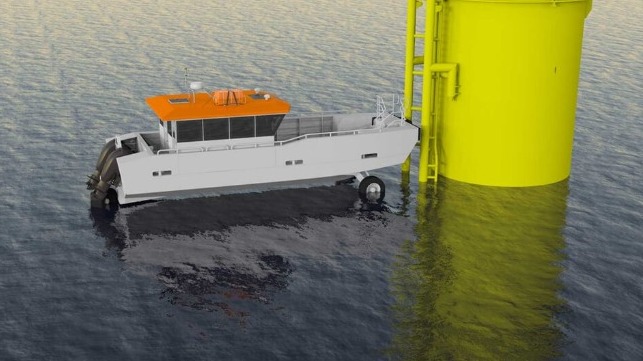First “Drive to Work” Amphibious CTV for Shallow Water Wind Farms

Addressing the challenges of reaching shallow water wind farms and turbines that are becoming stranded by rising sandbanks, German utility RWE working with Commercial Rib Charters, a UK-based operator of offshore support vessels, has designed the first amphibious Crew Transfer Vessel. According to the companies, the unique design provides a solution and the potential for worldwide application for wind farms in very shallow waters.
RWE, in partnership with Commercial Rib Charters, designed the unique vessel as a solution to a problem the company was facing at its Scroby Sands Wind Farm located approximately 1.6 miles off the coast of Great Yarmouth in eastern England. Commissioned in 2004, the 60 MW farm with 30 turbines was built on a sandbar.
The unique crew transfer vessel was designed to reach the turbines at Scroby Sands, which according to RWE have become stranded by the natural rising tide of the sandbank on which it is built. The prehistoric sandbank on which the farm is located, because of natural changes in the marine environment and coastal erosion, has risen over time effectively isolating four turbines from being accessed by service vessels.
“The new amphibious maintenance vessel at Scroby Sands is really exciting; it’s a great testimony to the talent of our employees and contractors, and once again demonstrates RWE and its partners leading the way in future-proofing offshore wind,” said Sven Utermöhlen, CEO wind offshore, RWE Renewables. “Innovation is a critical part of the energy transition, supporting the growth of the offshore industry and ensuring the long-life operations of our offshore wind fleet in the UK and around the world.”
The fully seaworthy vessel, which can also drive on land, provides a unique access solution for some of the industry’s first-generation CRC, assets affected by very dynamic seabed conditions and could play a role in the future development of other locations.
The unique vessel, which will be named CRC Walrus in honor of a classic 1930’s Supermarine amphibious biplane, is a 39-foot type-approved crew transfer vessel, with a 1000 kg deck cargo capacity. It has two wheels at the front and one at the back and is capable of transferring 10 technicians and two crew to any of the turbines within the array at Scroby Sands, including on the raised sandbank.
Stuart Hedges of Commercial Rib Charter said that they had signed the build contract with the Isle of Wight-based boat builders Diverse Marine in December, and plan to be operational at Scroby in September this year. The vessel will be operated for RWE by CRC under a six-year contract.
